


Adolescent idiopathic scoliosis is both the predominant spine deformity and the predominant form of scoliosis, affecting approximately 80% to 85% of all scoliosis patients. The reported prevalence typically ranges from 1%-3%. In 2010 and 2011 alone, US hospitals discharged more than 12,000 adolescent patients with idiopathic scoliosis, costing the nation more than $1.8 billion. As scoliosis affects some of the youngest orthopaedic patients who require permanency in their treatments, the instrumented-fusion should provide stabilization for many decades of life.
Current Research
At the JVL Research Center at Orthopaedic Institute for Children, biomechanical engineers and pediatric orthopaedic surgeons collaborate regularly to address clinical and surgical problems in the lab.
Our team has developed several in vitro models to simulate the surgical procedures that are performed to allow surgeons to compare the efficacy of various corrective maneuvers in the laboratory. These in vitro models offer the advantage of testing surgical procedures pre-operatively.
The research projects focusing on scoliosis and related surgeries have been published in major international journals.
Researchers
Sophia Sangiorgio, PhD
Eddie Ebramzadeh, PhD
Richard Bowen, MD
Anthony Scaduto, MD
Selected Publications
Borkowski, S. L., Sangiorgio, S. N., Bowen, R. E., Scaduto, A. A., He, B., Bauer, K. L., & Ebramzadeh, E. (2016). Strength of Thoracic Spine Under Simulated Direct Vertebral Rotation: A Biomechanical Study. Spine Deformity, 4(2), 85-93.
Borkowski, S. L., Sangiorgio, S. N., Bowen, R. E., Scaduto, A. A., Kwak, J., & Ebramzadeh, E. (2017). Flexibility of thoracic spines under simultaneous multi-planar loading. European Spine Journal, 26(1), 173-180.
Sangiorgio, S. N., Borkowski, S. L., Bowen, R. E., Scaduto, A. A., Frost, N. L., & Ebramzadeh, E. (2013). Quantification of increase in three-dimensional spine flexibility following sequential Ponte osteotomies in a cadaveric model. Spine Deformity, 1(3), 171-178.